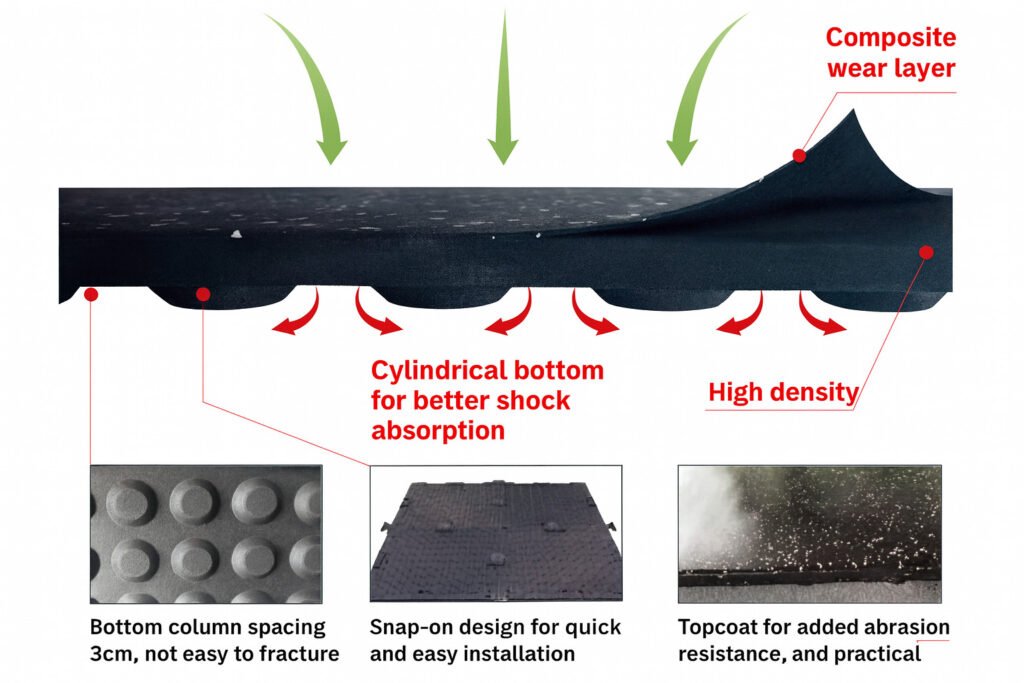Composite Gym Rubber Tile – Structure, Benefits, and Applications
Bad flooring can ruin a gym. Heavy weights damage floors, poor shock absorption causes injuries, and cheap tiles wear out quickly.
Composite gym rubber tiles solve these problems with multi-layer design – a durable surface, high-density structure, and shock-absorbing bottom. They are one of the best choices for 2025 gym flooring projects.

Composite tiles are now a popular upgrade for gyms that want safety, performance, and long-term value. Let’s break down their structure, specs, and benefits.
Product Structure – Why It Works
The cross-section of composite gym tiles reveals why they perform better than standard rubber tiles:
- Composite wear layer: tough surface that resists abrasion and keeps its look.
- High-density core: solid support for heavy weights and long lifespan.
- Cylindrical bottom: engineered shock absorption to protect joints and reduce noise.
- Snap-on design: fast installation and easy replacement without glue.
- Column spacing (3 cm): prevents cracks and improves flexibility.
For a wider comparison of different tile types, see our Rubber Floor Tiles Buying Guide.
Product Specifications
- Size: 500×500mm / 1000×1000mm
- Thickness: 20–50mm
- Materials: SBR base + composite EPDM surface
- Color options: black, grey, red, or speckled EPDM dots
- Certification: CE, EN1177 for safety and impact absorption
For a full knowledge base, check the Gym Rubber Flooring Complete Guide 2025.
Applications – Where to Use Composite Tiles
Composite gym tiles are best in areas that face heavy impact and need both strength and looks:
- Weightlifting zones with barbells and dumbbells
- CrossFit and HIIT studios
- Personal training studios
- Multi-functional strength areas
- Premium commercial gyms
They are also suitable for projects that need fast installation and long durability, such as new gym chains or renovations.
For outdoor flooring ideas, see 2025 Outdoor Rubber Floor and EPDM Flooring Selection Guide.
Advantages Compared to Standard Tiles
| Feature | Composite Tile | Tiny Granule Tile |
|---|---|---|
| Shock absorption | Cylindrical bottom, excellent cushioning | Good, flat base |
| Surface durability | Composite wear layer, high resistance | Single-layer, wears faster |
| Installation | Snap-on design, easy to replace | Often glued down |
| Lifespan | High-density core, longer use | Standard durability |
| Appearance | Premium, customizable | More basic, simple look |
Want to explore roll flooring for cardio and yoga areas? Check the 2025 Expert’s Guide to Rubber Flooring Rolls for Gyms.
Customer Value
- Safety: protects athletes and flooring from heavy drops.
- Economy: longer lifespan reduces replacement costs.
- Flexibility: modular snap-on system allows quick changes.
- Branding: professional look improves gym image and customer experience.
If you’re sourcing suppliers, review our guide on 2025 Distribution of Gym Rubber Flooring Suppliers in China.
How to Choose Composite Gym Tiles
- Define the zone: weightlifting vs functional vs cardio areas.
- Select the surface:
- SBR base (budget-friendly)
- 15% EPDM speckled surface (most popular balance of cost and looks)
- 100% EPDM surface (premium, most durable, highest cost)
- Check certifications: request CE and EN1177 reports to confirm safety.
- Plan installation: snap-on tiles are easier to replace than glued tiles.
For other flooring comparisons, see 2025 Most Popular Gym Flooring Options – 5 Products You Should Know.
Related Blogs
- Rubber Floor Tiles Buying Guide
- 2025 Expert’s Guide to Rubber Flooring Rolls for Gyms
- 2025 Distribution of Gym Rubber Flooring Suppliers in China
- 2025 Outdoor Rubber Floor and EPDM Flooring Selection Guide
- Complete Guide: Gym Rubber Flooring Knowledge 2025
- 2025 Most Popular Gym Flooring Options – 5 Products You Should Know
FAQ – Composite Gym Rubber Tiles
Q1: Why choose composite tiles over standard rubber tiles?
A1: They offer better shock absorption, easier installation, and longer lifespan.
Q2: Are composite tiles more expensive?
A2: Yes, especially with 100% EPDM surface, but 15% EPDM speckled tiles are the most popular for balance of cost and looks.
Q3: Can they be installed without glue?
A3: Yes, snap-on designs allow modular installation and fast replacement.
Q4: Do they meet safety standards?
A4: Reliable suppliers provide CE and EN1177 certifications. Always verify documents before purchase.
Q5: Where can I learn more about gym flooring safety?
A5: Check IHRSA for global fitness facility standards.
Conclusion
Composite gym rubber tiles combine durability, safety, and design in one product. With multi-layer structure and modular installation, they are the best solution for gyms upgrading in 2025.
